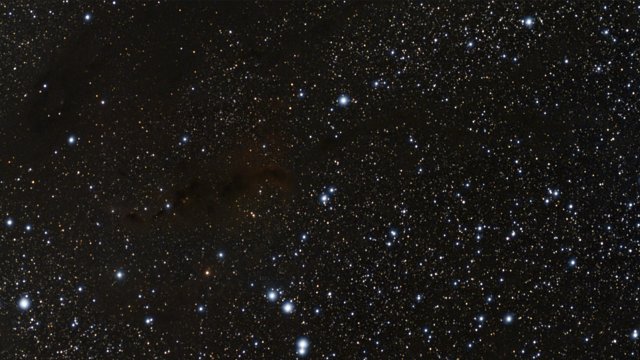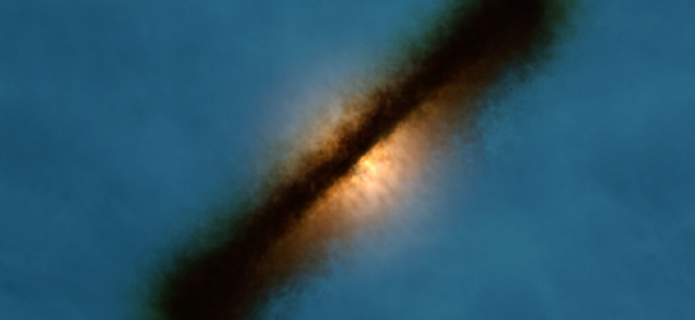ALMA Finds Double Star with Weird and Wild Planet-forming Discs
30 July, 2014 / Read time: 7 minutes
Astronomers using the Atacama Large Millimeter/submillimeter Array (ALMA) have found wildly misaligned planet-forming gas discs around the two young stars in the binary system HK Tauri. These new ALMA observations provide the clearest picture ever of protoplanetary discs in a double star. The new result also helps to explain why so many exoplanets — unlike the planets in the Solar System — came to have strange, eccentric or inclined orbits. The results will appear in the journal Nature on 31 July 2014.
Unlike our solitary Sun, most stars form in binary pairs -- two stars that orbit around each other. Though remarkably plentiful, binaries pose a number of questions, including how and where planets form in such complex environments.
Fig. 1: Artist's impression of the misaligned protoplanetary disks around the binary stars in HK Tau. Credit: R. Hurt (NASA/JPL-Caltech/IPAC)
"ALMA has given us an unprecedented view of a main star and its binary companion sporting mutually misaligned protoplanetary disks," said Eric Jensen, an astronomer at Swarthmore College in Pennsylvania, USA.
The two stars in the HK Tauri system, which is located about 450 light-years from Earth in the constellation Taurus, are less than 5 million years old and separated by about 58 billion kilometers, or 13 times the distance of Neptune from the Sun.
This system's companion star, dubbed HK Tau B, appears fainter to astronomers on Earth because its disk of dust and gas blocks out much of the starlight. However, since its faint glow is swamped by the dazzling brightness of the star, the disc can be readily detected in visible light and near-infrared wavelengths.
Fig. 2: ALMA data of HK Tau shown in a composite image with Hubble infrared and optical data. Credit: B. Saxton (NRAO/AUI/NSF); K. Stapelfeldt et al. (NASA/ESA Hubble)
The disk around the main star, HK Tau A, is tilted in such a way that the light from its host star shines through unobscured, making it difficult for astronomers to see the disk optically. This is not a problem for ALMA, however, which can readily detect the millimeter-wavelength light emitted by the dust and gas that comprise the disk.
With its unprecedented resolution and sensitivity, ALMA was able to fully resolve the rotation of HK Tau A's disk for the first time. This clearer picture enabled the astronomers to calculate that the two discs are out of alignment with each other by at least 60 degrees. So rather than being in the same plane as the orbits of the two stars at least one of the discs must be significantly misaligned.
"This clear misalignment has given us a remarkable look at a young binary star system," said Rachel Akeson of the NASA Exoplanet Science Institute at the California Institute of Technology in Pasadena, California. "Though there have been hints before that this type of misaligned system exists, this is the cleanest and most striking example of what is really going on in one of these systems."
Fig. 3: The key velocity data taken with ALMA that helped the astronomers determine that the disks in HK Tau were misaligned. The red areas represent material moving away from Earth and the blue indicates material moving toward us. Credit: NASA/JPL-Caltech/R. Hurt (IPAC)
Stars and planets form out of vast clouds of dust and gas. As material in these clouds contracts under gravity, it begins to rotate until most of the dust and gas falls into a flattened protoplanetary disk swirling around a growing central protostar.
But in binary systems like HK Tauri things are much more complex. When the orbits of the stars and the protoplanetary discs are not roughly in the same plane any planets may end up in highly eccentric and tilted orbits [1].

This video takes us from a broad view of the sky deep into the star forming clouds of Taurus. The final sequence shows an artist’s impression of HK Tauri, a young double star with a protoplanetary disc around each of its component stars. ALMA observations of this system have provided the clearest picture ever of protoplanetary discs in a double star. The new result demonstrates one possible way to explain why so many exoplanets — unlike the planets in the Solar System — came to have strange, eccentric or inclined orbits. Credit: ESO/Digitized Sky Survey 2/N. Risinger (skysurvey.org). Music: movetwo
"Our results demonstrate that the necessary conditions exist to modify planetary orbits and that these conditions are present at the time of planet formation, apparently due to the binary formation process," noted Jensen. "We can’t rule other theories out, but we can certainly rule in that a second star will do the job."
Since ALMA can see the otherwise invisible dust and gas of protoplanetary disks, it allowed for never-before-seen views of this young binary system. "Because we’re seeing this in the early stages of formation with the protoplanetary disks still in place, we can see better how things are oriented," noted Akeson.
Looking forward, the researchers want to determine if this type of system is typical or not. They note that this is a remarkable individual case, but additional surveys are needed to determine if this sort of arrangement is common throughout our Galaxy.
Fly-in animation of HK Tau and its pair of misalgned planet-forming disks. Credit: Brian Kent, Bill Saxton, Jeff Hellerman (NRAO/AUI/NSF); NASA/JPL-Caltech/R. Hurt (IPAC); NASA/ESA Hubble Karl Stapelfeldt (JPL) et al.
Notes
[1] If the two stars and their discs are not all in the same plane, the gravitational pull of one star will perturb the other disc, making it wobble or precess, and vice versa. A planet forming in one of these discs will also be perturbed by the other star, which will tilt and deform its orbit.
More Information
The Atacama Large Millimeter/submillimeter Array (ALMA), an international astronomy facility, is a partnership of the European Organisation for Astronomical Research in the Southern Hemisphere (ESO), the U.S. National Science Foundation (NSF) and the National Institutes of Natural Sciences (NINS) of Japan in cooperation with the Republic of Chile. ALMA is funded by ESO on behalf of its Member States, by NSF in cooperation with the National Research Council of Canada (NRC) and the Ministry of Science and Technology (MOST) in Taiwan and by NINS in cooperation with the Academia Sinica (AS) in Taiwan and the Korea Astronomy and Space Science Institute (KASI).
ALMA construction and operations are led by ESO on behalf of its Member States; by the National Radio Astronomy Observatory (NRAO), managed by Associated Universities, Inc. (AUI), on behalf of North America; and by the National Astronomical Observatory of Japan (NAOJ) on behalf of East Asia. The Joint ALMA Observatory (JAO) provides the unified leadership and management of the construction, commissioning and operation of ALMA.
This research was presented in a paper entitled “Misaligned Protoplanetary Disks in a Young Binary Star System”, by Eric Jensen and Rachel Akeson, to appear in the 31 July 2014 issue of the journal Nature.
The team is composed of Eric L. N. Jensen (Dept. of Physics & Astronomy, Swarthmore College, USA) and Rachel Akeson (NASA Exoplanet Science Institute, IPAC/Caltech, Pasadena, USA).
Contact:
Eric L. N. Jensen
Lead Scientist, Swarthmore College
Philadelphia, USA
Tel: +1 610-328-8249
Email: [email protected]
Rachel Akeson
NASA Exoplanet Science Institute, IPAC/Caltech
Pasadena, USA
Tel: +1 626-395-1812
Email: [email protected]
Valeria Foncea
Education and Public Outreach Officer
Joint ALMA Observatory
Santiago, Chile
Tel: +56 2 467 6258
Cell: +56 9 75871963
Email: [email protected]
Charles E. Blue
Public Information Officer
National Radio Astronomy Observatory
Charlottesville, Virginia, USA
Tel: +1 434 296 0314
Cell: +1 434.242.9559
E-mail: [email protected]
Richard Hook
Public Information Officer, ESO
Garching bei München, Germany
Tel: +49 89 3200 6655
Cell: +49 151 1537 3591
Email: [email protected]
Masaaki Hiramatsu
Education and Public Outreach Officer, NAOJ Chile
Observatory Tokyo, Japan
Tel: +81 422 34 3630
E-mail: [email protected]





